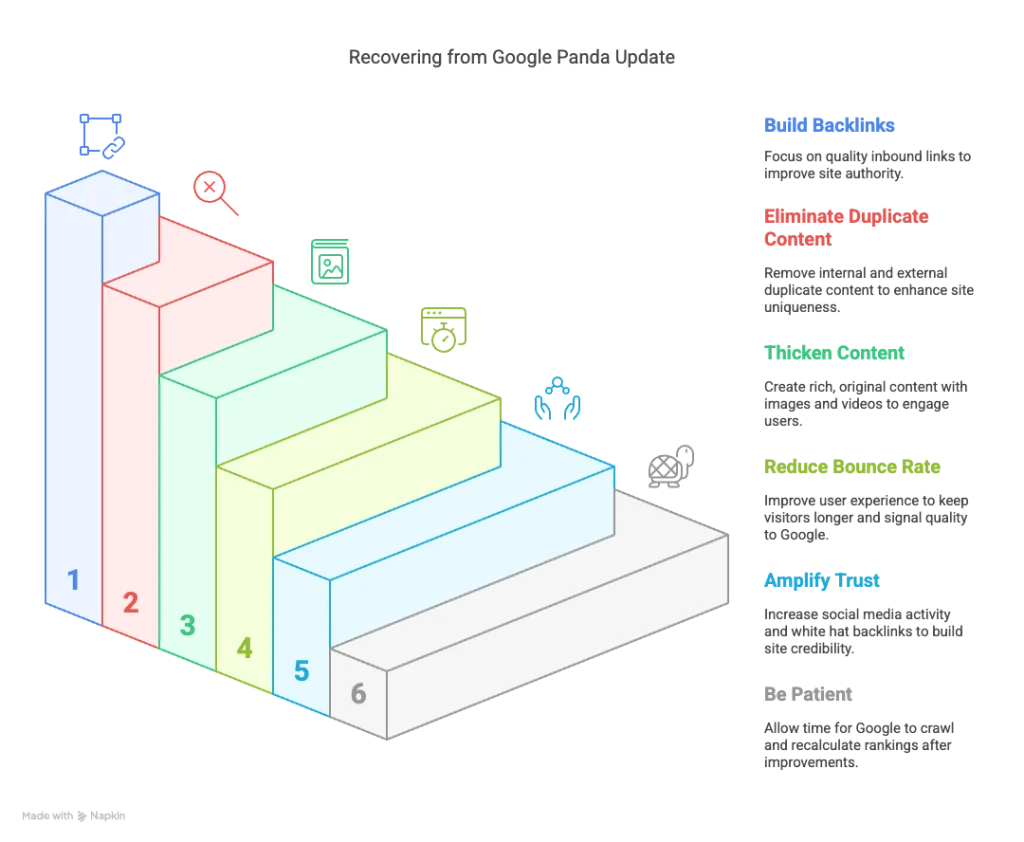Although it’s now well over six months since the infamous Google Panda Update that shook the SEO world to it’s core, many webmasters still have not regained their rankings. Now more than ever, the quality of on-page content matters. If your site(s) have lost their ranking due to the Google Panda update, there is hope. Here are 11 things that you can start in on right now to rectify these issues.
1.) Build better backlinks
Although the Panda update was directed at on-page factors by Google’s search quality team, many have failed to think about their inbound links. Mass distribution to article directories, link wheeling, and private blog networks have surely taken a hit. If your site meets all of the following criteria, think about the sites/pages that your backlinks reside on.
2.) Eliminate duplicate content internally
A lot of people have complained of scraper sites taking their content, then passing them up in the SERP’s. This is undeniably something that Google continues to struggle with treating. In many cases, this can be overcome through eliminating content farm signals. Many content farms that scrape from around the web do a very poor job of eliminating duplicate and low quality content internally (as there are no editors), so not doing this can send the wrong message. Using the rel=”canonical” tag, and eliminating internally duplicate content, can and will make your site look higher quality in Google’s eyes. Tag clouds may also have to go.
3.) Eliminate duplicate content externally
No doubt, if your content looks like the content on other sites, the likelihood of ranking issues is high. Some black hats succeed at circumventing this issue using content spinners, but that often will only go so far. Make sure your content is completely unique and well-written. If you are syndicating from other sites, consider rewriting stories by hand before publishing. The SEO benefits of doing so could very well exceed even what you were seeing before the Panda update.

4.) Thicken your content
Aim to have at least 500 words of well-crafted, original content per page that is unique and rich as possible. Include lots of images, and when possible, video. Google loves video. Look at each page of your site and ask, is this truly useful to a user? If you can answer yes, you should find yourself coming back from the Panda update, and succeeding through future algorithm updates as well.
5.) Eliminate thin content
If you are not able to make content more rich and useful as a search engine landing page, consider removing it from your site. Remove the page. Remove it’s backlinks. 301 redirect the old URL to a more useful area if another area is at all relevant.
6.) ‘noindex’ thin content
If you can’t eliminate thin content, consider using the ‘noindex,follow’ directive either in a meta tag or robots.txt file. By holding Google’s hand in finding what’s useful on your site, you can gain additional trust in having content that is.
7.) Watch your ‘link to text’ ratio
Too many links in relation to the amount of overall text has also had a tendency to hurt web sites after Google Panda. Try to reduce the amount of links that you have per page. If you have more than one link per 100 words (main site navigation excluded), there’s a high likelihood that it’s hurting you.
8.) Reduce your bounce rate
Many SEO experts think Google increasingly sees a site’s bounce rate as important. When someone clicks your link in Google’s search results, Google tracks how long they stay on your site using a cookie. If this time is too short, Google decides the user didn’t like the site. Because of this, Google might rank the site lower.
9.) Consider amplifying your site’s trust in other ways
Whereas you may have lost out in some search rankings thanks to the Google Panda update, all is not lost. Remember, Matt Cutts has repeatedly reiterated that this update was brought forward by Googles search quality team. That is very different from the webspam team, from which Matt generally speaks to us. In other words- Panda is not a penalty. It is not looking for you doing something wrong, it’s looking at what other people are doing much better. Consider garnering more social media activity, and some strong, white hat backlinks, for starters.
10.) Be patient
Google needs time to crawl pages. Recalculating rankings with all important factors in mind often takes much longer. Continuously make improvements. However, don’t get discouraged if months go by and your site’s ranking doesn’t improve. If you work at making your site of high quality for long enough, Google will reward you.
11.) Hire someone else to deal with it
If all else fails, consider hiring an SEO consultant with a solid reputation to help dig you out of the hole that you’ve fallen into. One thing is for certain- Google is not going to help you. You may need an outside professional.



